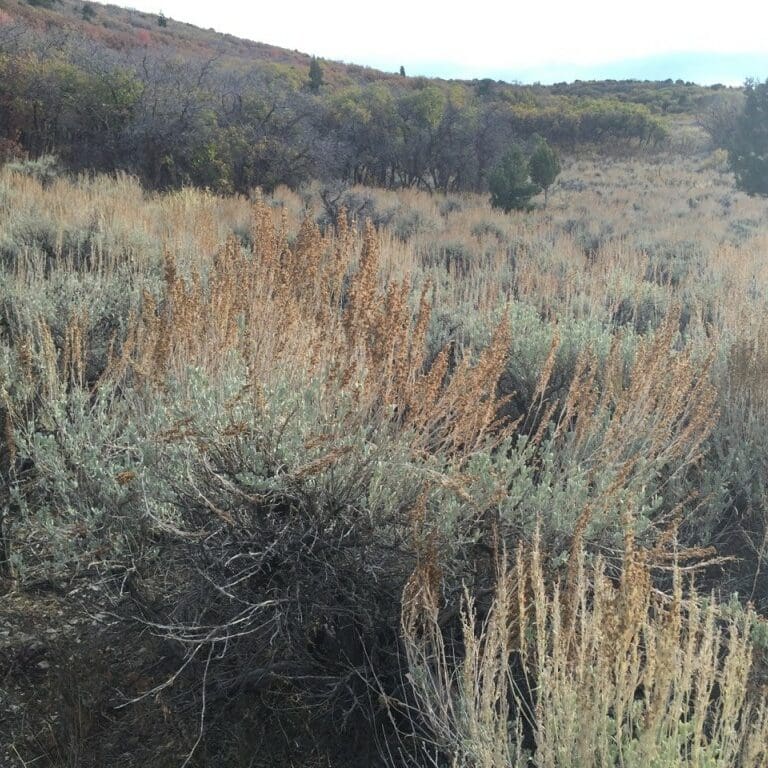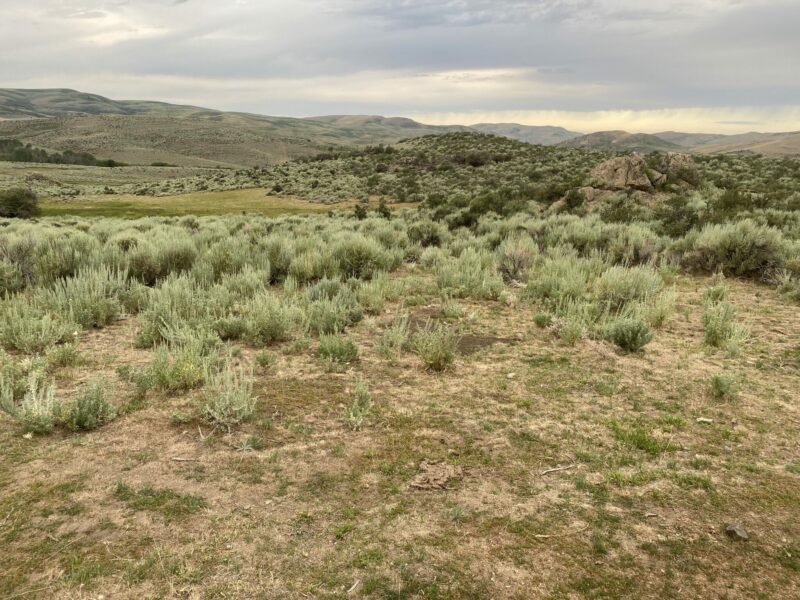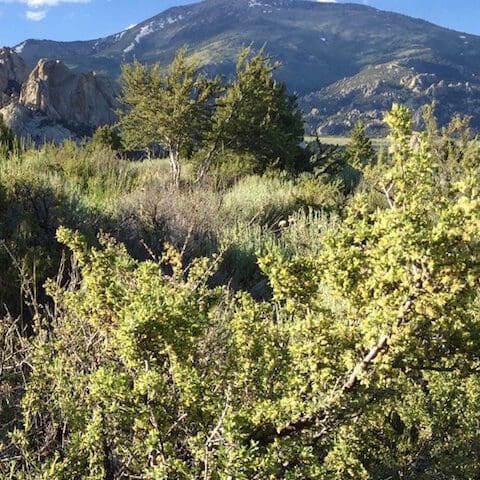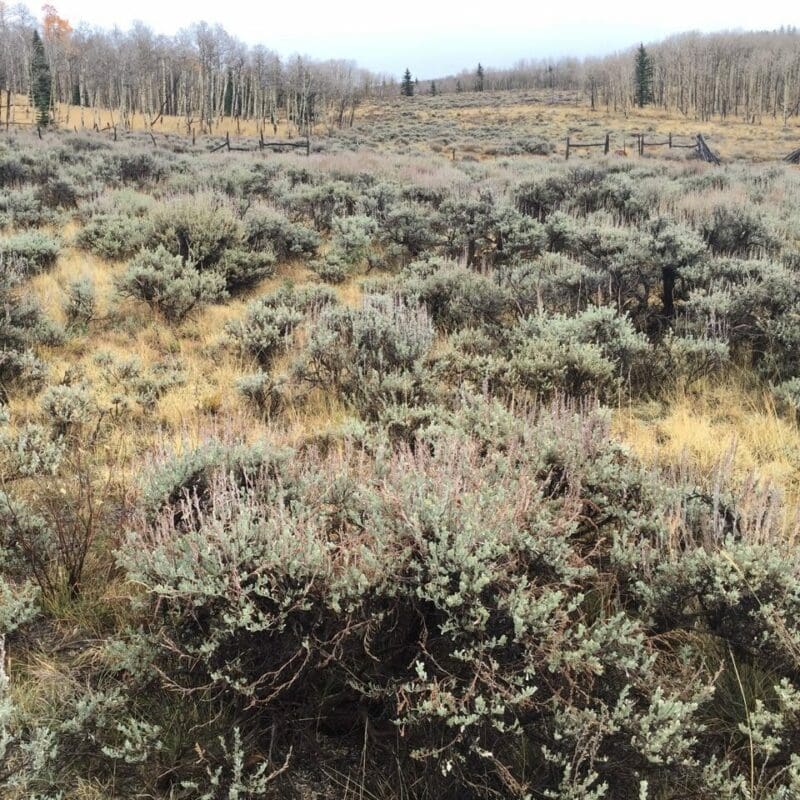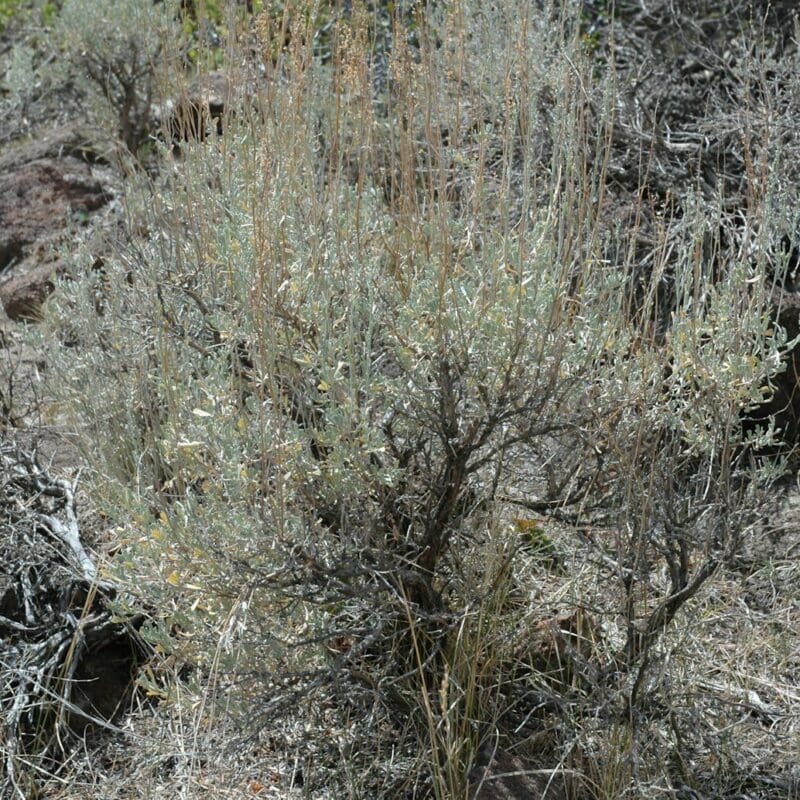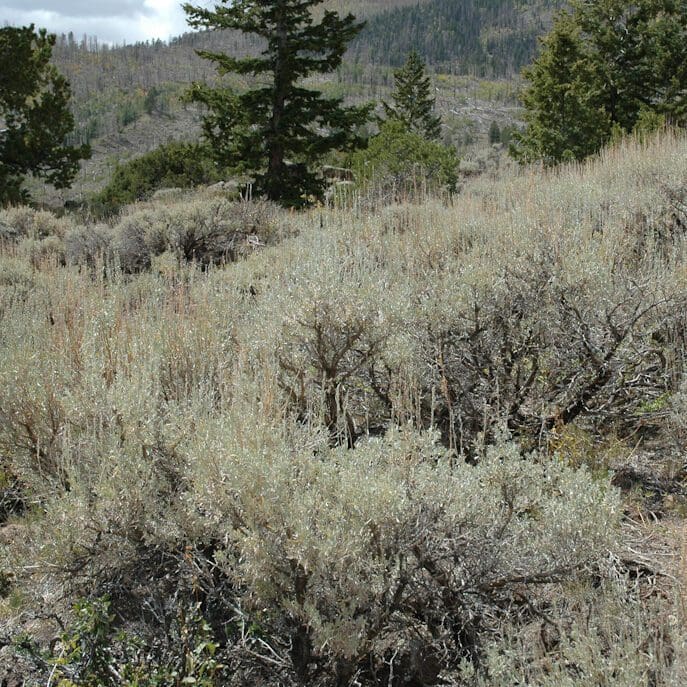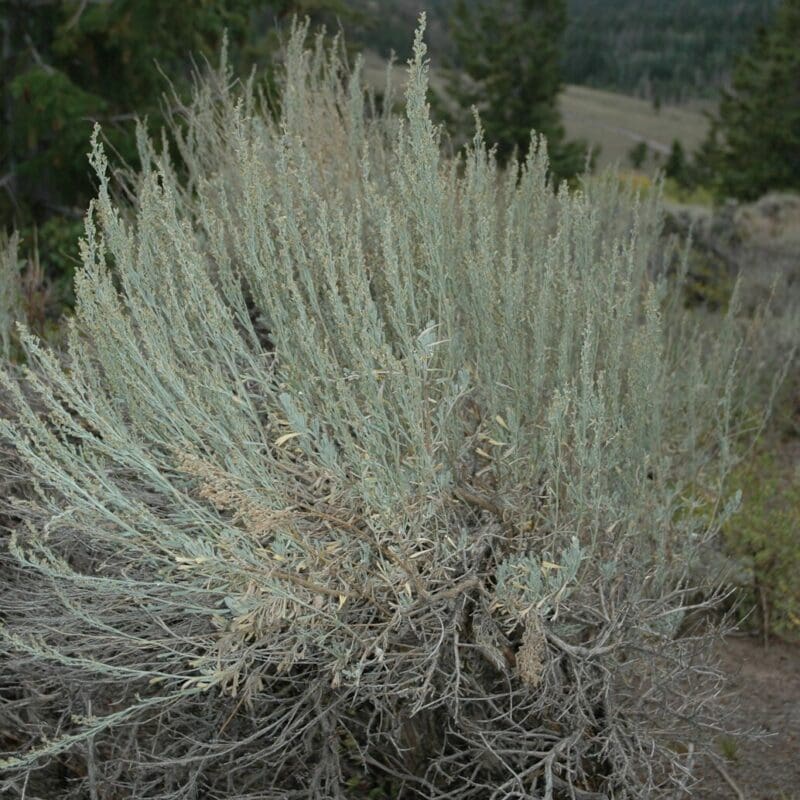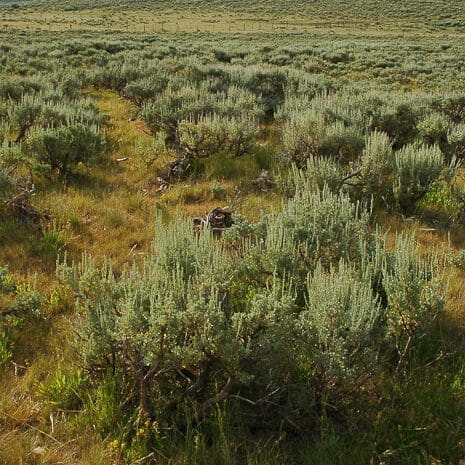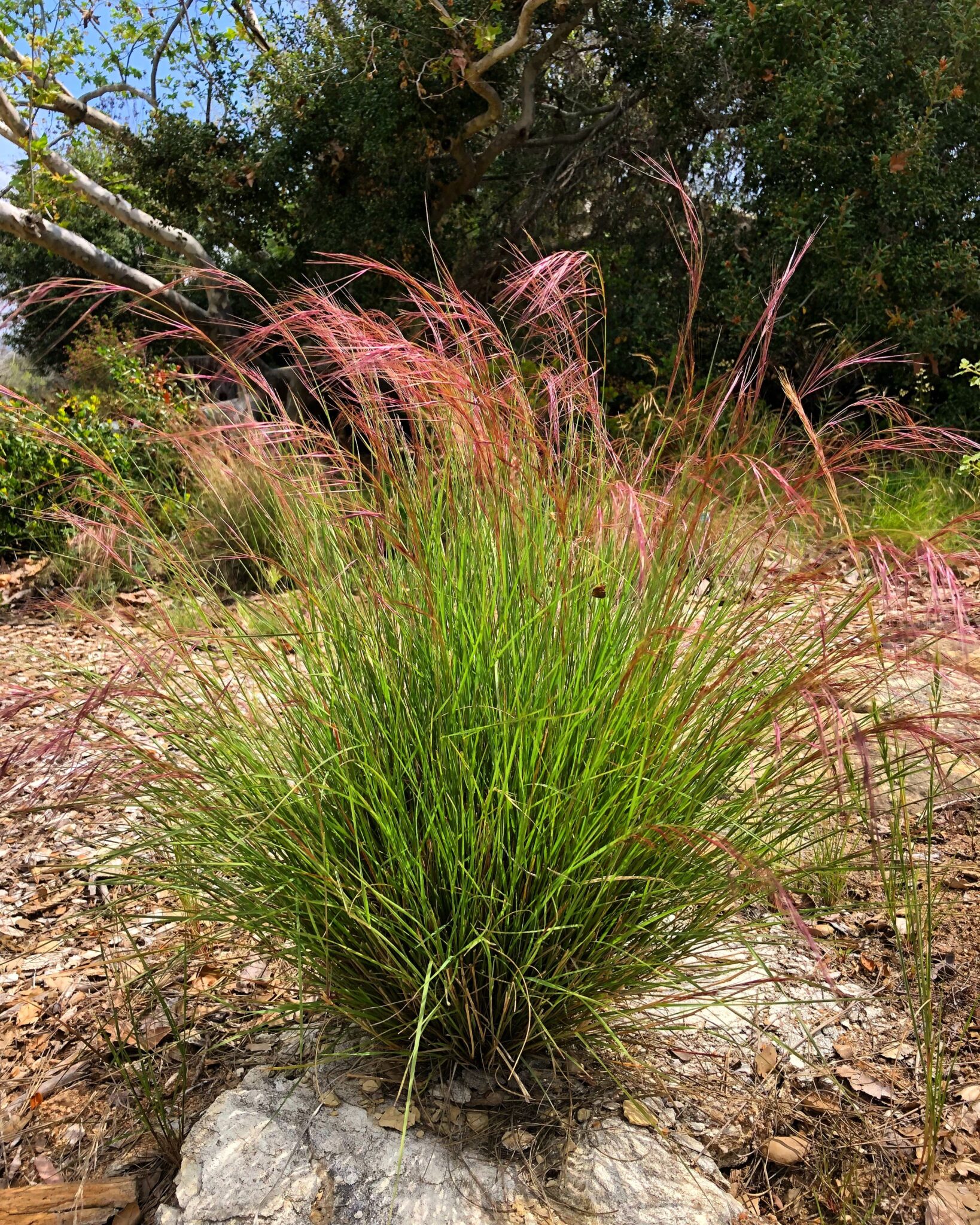
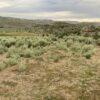
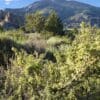


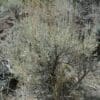
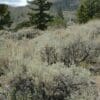
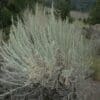
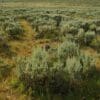
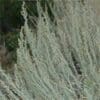
Mountain Big Sagebrush
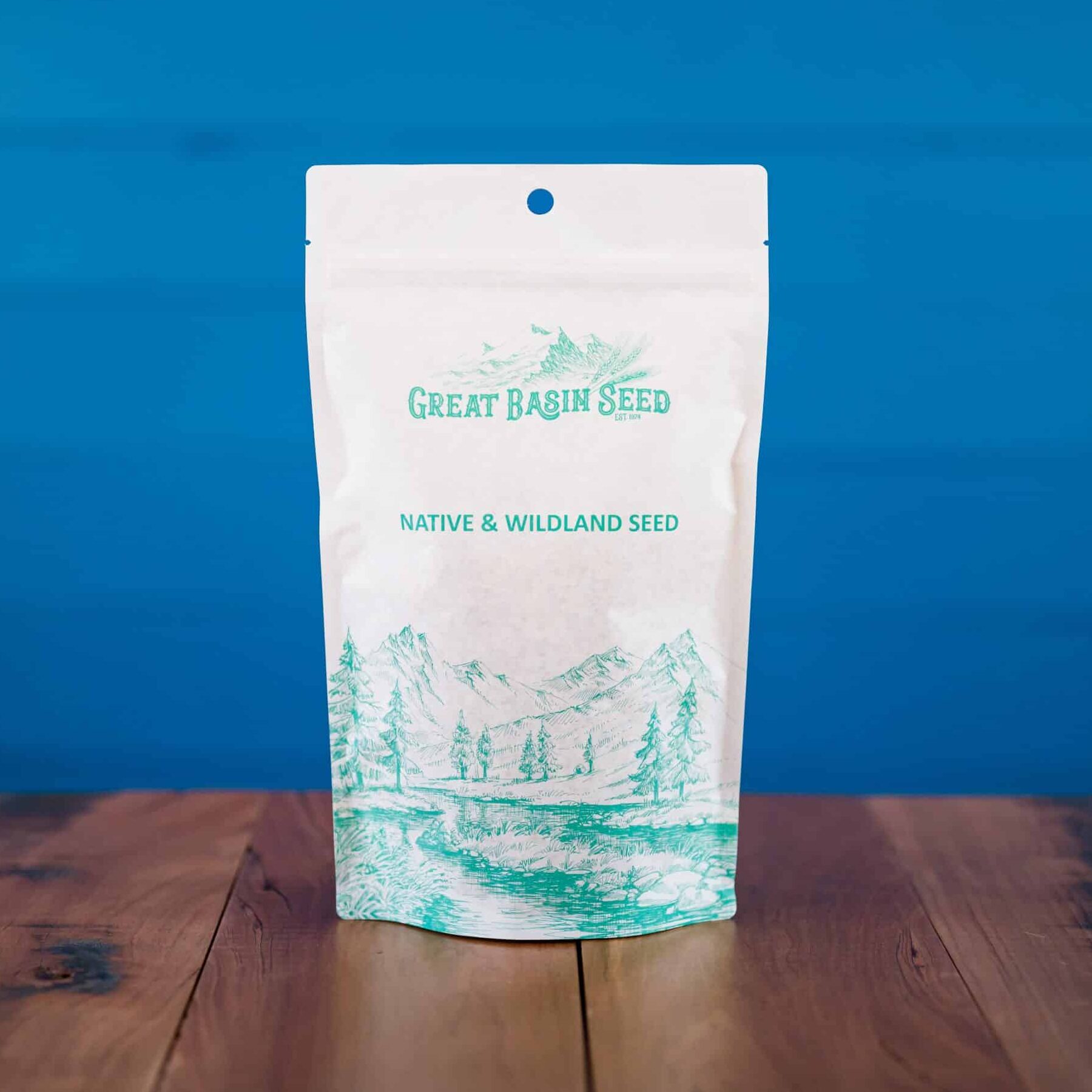 $2.75 – $21.85
$2.75 – $21.85 Mountain Big Sagebrush
- Scientific name: Artemsia tridentatat vasseyena
- Adapted to well-drained medium depth soils on higher benches, upper mountain slopes and meadows
- Provides valuable cover for wildlife
- Blooms in the fall
- Very important for revegetation efforts
- Wide range of adaptation and ease of establishment
Mountain Big Sagebrush (Artemesia tridentata vasseyena), also known as Vaseyana or “Vassey” Sagebrush. Adapted to well-drained medium depth soils on higher benches, upper mountain slopes and meadows. Palatability varies but generally poor for livestock and good for wildlife. Provides valuable cover for wildlife. Mountain Big Sagebrush blooms in the fall. It is distinguished by elevation of occurrence, and it’s distinct menthol odor. Tall, erect stems are generally flat or “butched” on top.
Forage/Wildlife: Big sagebrush is perhaps the most important shrub on western rangelands. Evergreen leaves and abundant seed production provide an excellent winter food source to numerous species of large mammals including mule deer, black-tailed deer, white-tailed deer, elk, pronghorn antelope, bighorn sheep and jack rabbits. Nearly 100 bird species depend on sagebrush ecosystems for their habitat needs. Additionally, there are several animal species having an obligate relationship with big sagebrush including sage grouse, sharp tailed grouse, pygmy rabbits, sage thrashers, sage sparrows and Brewer‟s sparrow. Sagebrush also provide habitat and food for hosts of invertebrates which in turn support birds, reptiles and small mammals. In addition to the numerous species of animals that depend on sagebrush for food and cover, there are several plant species having close relationships with sagebrush as well.
Sagebrush plants maintain high levels of most nutrients including crude protein (see table 1). This high forage value makes it especially useful for wildlife, and in some areas livestock, winter grazing. Separate studies indicated that sagebrush made up 78% of the annual diet for antelope in Wyoming and 59% of the winter diet of deer and elk near Gardiner, Montana. Sagebrush also makes up close to 100% of the winter diet of sage grouse and over 60% of their total annual diet. Use of sagebrush by livestock is limited and variable.
Animal preference of sagebrush varies with subspecies, populations and even individual plants due to chemical variation found in the foliage. Deer and elk tend to prefer mountain big sagebrush followed by Wyoming big sagebrush and finally basin big sagebrush. Although many range managers believe that deer and other large mammals prefer to browse shrubby members of the Rosaceae such as mountain mahogany (Cercocarpus), bitterbrush (Purshia) and cliffrose (Cowania) over big
Revegetation/reclamation: Because of its wide range of adaptation and ease of establishment, big sagebrush is very important for revegetation efforts. Seedlings are able to compete with grasses and forbs allowing it to be used as a component of a wide range of seed mixes. Seedlings are very easy to establish when planted correctly (see “Establishment” section) and can be drill seeded or broadcast with near equal levels of success. Because sagebrush plants spread readily by seed, it can be seeded at relatively low rates and allowed to spread by natural recruitment.
Big sagebrush plants provide many additional benefits to the plant community. The dense canopy protects understory herbaceous plants from grazing. Healthy sagebrush communities provide a multi- tiered ecosystem with high levels of biodiversity. Big sagebrush plants also have a two-part root system with a deep tap root and a shallow, diffuse root system. Studies have shown sagebrush plants create “hydraulic lift” where deep moisture is brought to the soil surface by the tap root during the day and then released into the upper soil at night. This water is then available to the diffuse root system of big sagebrush as well as to the roots of other understory plants. Sagebrush plants also increase water retention by trapping and holding windblown snow.
Big sagebrush subspecies are often useful indicators of soil characteristics.
The stems of mountain big sagebrush create an even topped crown with the panicles rising distinctly and relatively uniformly above the foliage. Plants are normally smaller than those of basin big sagebrush, averaging about 0.9 m (3 ft) tall. Inflorescences are narrow and spicate bearing flower heads containing 4 to 8 flowers per head. Leaves are characteristically wider than those of basin or Wyoming big sagebrush. In extracts, ultraviolet visible coumarins are abundant. Leaf extracts fluoresce blue in water and blue-cream in alcohol. 2n = 18 or sometimes 36.
Habitat: The big sagebrush complex is adapted to a wide range of precipitation zones and soil conditions. Plants are well adapted to the arid plains, valleys, foothills and mountains of the West in annual precipitation ranges from 8 to 30 inches. It is often found growing in loamy to sandy loam soils. Tolerance to alkalinity or acidity varies by subspecies. In general, big sagebrush will grow in pH of 5.9 to 10.0.
Mountain big sagebrush grows in mountain and mountain foothills from 2,600 to 10,000′. It occurs with rabbitbrush, piñon pine, juniper, mountain shrub, aspen, Douglas fir, ponderosa pine and spruce-fir habitats. Plants prefer moderately deep to deep, well-drained soils providing summer moisture. Mountain big sagebrush occurs at higher elevations and in higher annual precipitation zones than Wyoming or basin big sagebrush. Soils are typically 18 to 36 in deep or more, and are most often loamy to gravelly. Plants commonly grow in areas receiving over 14 inches annual precipitation but may be found in lower elevations and precip zones.
Plant seed into a firm, weed-free seedbed at a depth of no more than 1/8 inch. Seed covered too deeply with soil will generally fail to establish. Surface broadcast seed that has been pressed into the soil produces best results. Seed can be broadcast directly onto snow with good results. Pressing broadcast seed into the soil surface with a land imprinter has provided very good establishment success. Land imprinters create good contact between the seed and soil and provide microhabitats that optimize temperature and water. Broadcast seeding has also yielded good results when followed by a cultipacker or drag chain.
Drill seeding is successful if strict attention is paid to seeding depth. Optimal drilling depth is 0 to 1/8 inch.
***Click on the “Quick Plant Facts” tab above for more information.
Big Sagebrush NRCS Plant Guide and Fact Sheet
Big Sagebrush NRCS Plant Guide and Fact Sheet
PDF version of NRCS Plant Guide & Fact Sheet
Prepared By: Derek J. Tilley, Range Conservationist, USDA NRCS
Plant Materials Center, Aberdeen, Idaho
Dan Ogle, Plant Materials Specialist, USDA NRCS
Idaho State Office, Boise, Idaho
Loren St. John, Manager, USDA NRCS Plant
Materials Center, Aberdeen, Idaho
Brock Benson, Area Range Conservationist, USDA
NRCS, Ogden, Utah
Species Coordinator: Dan Ogle, Plant Materials Specialist, USDA NRCS
Idaho State Office, Boise, Idaho
Pocket Guide to Sagebrush
Pocket Guide to Sagebrush
PDF version of Point Blue Conservation Science
Prepared By: Leila Shultz, Utah State University
Illustrations By: Linda Ann Vorobik
Design & Layout By: Scott Gillihan
Helpful Links
Additional information about this product can be found on the academic websites linked below.
Synonyms
Many plants have more than one common and scientific name. We've listed a few of them below.
- Mountain Big Sagebrush
- Artemisia tridentata spp vaseyana
Who is Great Basin Seed?
Great Basin Seed is a seed company that specializes in seed sales and consultation for home, ranch, farm, range and reclamation. We have been a leader in the seed industry since 1974.
Our History
We've been in the seed business since 1974.
What We Offer
We offer seed for home, farm, ranch, range and reclamation projects.
Meet the Gang
We have the best employees in the world! We are proud of the work they do, and trust them to serve you!
Right: Company founder Lloyd and his wife Paula Stevens in a wildflower seed production field circa 1977
Quick Plant Facts
| Common Name: | Mountain Big Sagebrush |
|---|---|
| Scientific Name: | |
| Lifespan: | |
| Plant Type: | |
| pH Tolerance: | |
| Seed Count | 2500000 |
| Root Form: | |
| Planting Rate: | |
| Min. Precipitation | 10 inches |
| Best Time to Sow: | |
| Sun & Shade Tolerance: | Full Sun |
| Hardiness Zones: | |
| Select a Package Size and Quantity | 1 oz. Envelope, 4 oz. Pouch (0.25 lbs.), 8 oz. Pouch (0.50 lbs.), 1 lb. (by the pound) |
